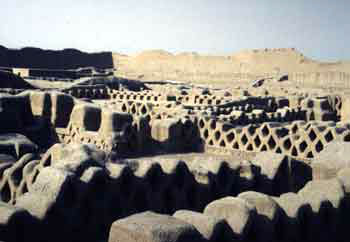They called the city “Jang-Jang,” which
means, “Sun-Sun” in Yunca, the Chimu language. The name evolved
into “Chan Chan” during the Spanish rule.
Chan Chan was the capital of the Chimus, who, before the Incas built
their mighty empire, dominated over 600 miles of Peru’s Pacific
coastline. The Chimu civilization lasted for almost five hundred years,
beginning around 950 A.D.
Located in a hot and dry valley, about 300 miles north of Lima near the
present day City of Trujillo, Chan Chan was the largest Pre-Columbian
South American urban center before the arrival of the Europeans. At its
height, Chan Chan had a population of over 50,000 and covered more than
15 square miles.
The city was built entirely of adobe, a local material perfectly suited
for the environment—it collects heat during the day and slowly
releases it at night. The adobe walls reached as high as 33 feet and
provided privacy while guarding against dust, sand and high winds.
The city itself consisted of ten enormous walled quadrangles, called
ciudadelas
(citadels), each built with only one entrance. Inside each
ciudadela were
large plazas, residences, temples, gardens, reservoirs, various rooms
and storage areas, and a cemetery. They were accessed along very wide
corridors. It is believed that only the aristocracy lived within these
quadrangles, as evidenced by the intricate decoration adorning the walls.
Carved into the adobe, the friezes represent local animals, sea life,
geometric shapes, and other designs. Some areas were also covered with
precious metals. The common people inhabited barrios outside of the
ciudadela’s
walls.
A
ciudadela was built by slaves for the king, his servants and
aristocracy. When the king died, it became his mausoleum. He was buried
there, surrounded by his treasures, and with him were also buried an
entourage of as many as 300 victims of sacrifice. The new king would
then have his own
ciudadela built, as did the king after him.
Today, as we stand on an observation platform overlooking the ruins of
Chan Chan, we can see the ruins of the successive
ciudadelas.
Living in an area with little rain, the Chimus constructed a series of
canals to transport water from the Andes. They also built sunken gardens
to attract water to their crops, a system still used in local farming
today. In addition to their engineering skills, the Chimus were also
artisans. Visiting the Chan Chan museum, we can see examples of their
skill with gold, ceramics, weaving, and pottery.
When the Incas finally conquered Chan Chan in the early 15th century,
they transferred most of the wealth to their own capital, Cuzco. Around
1470, Francisco Pizarro, the conquistador, reached Chan Chan, looking
for gold and treasures. He removed much of what the Incas left. As the
centuries passed, grave robbers continued the job of looting. Although
little of the riches remain, most of the city’s walls are intact
today, along with the friezes, and great plazas—a tribute to the
architectural and engineering capabilities of the Chimu people.
Click Here for information on our Peru Tours.


 By
Ellen Klein
By
Ellen Klein
